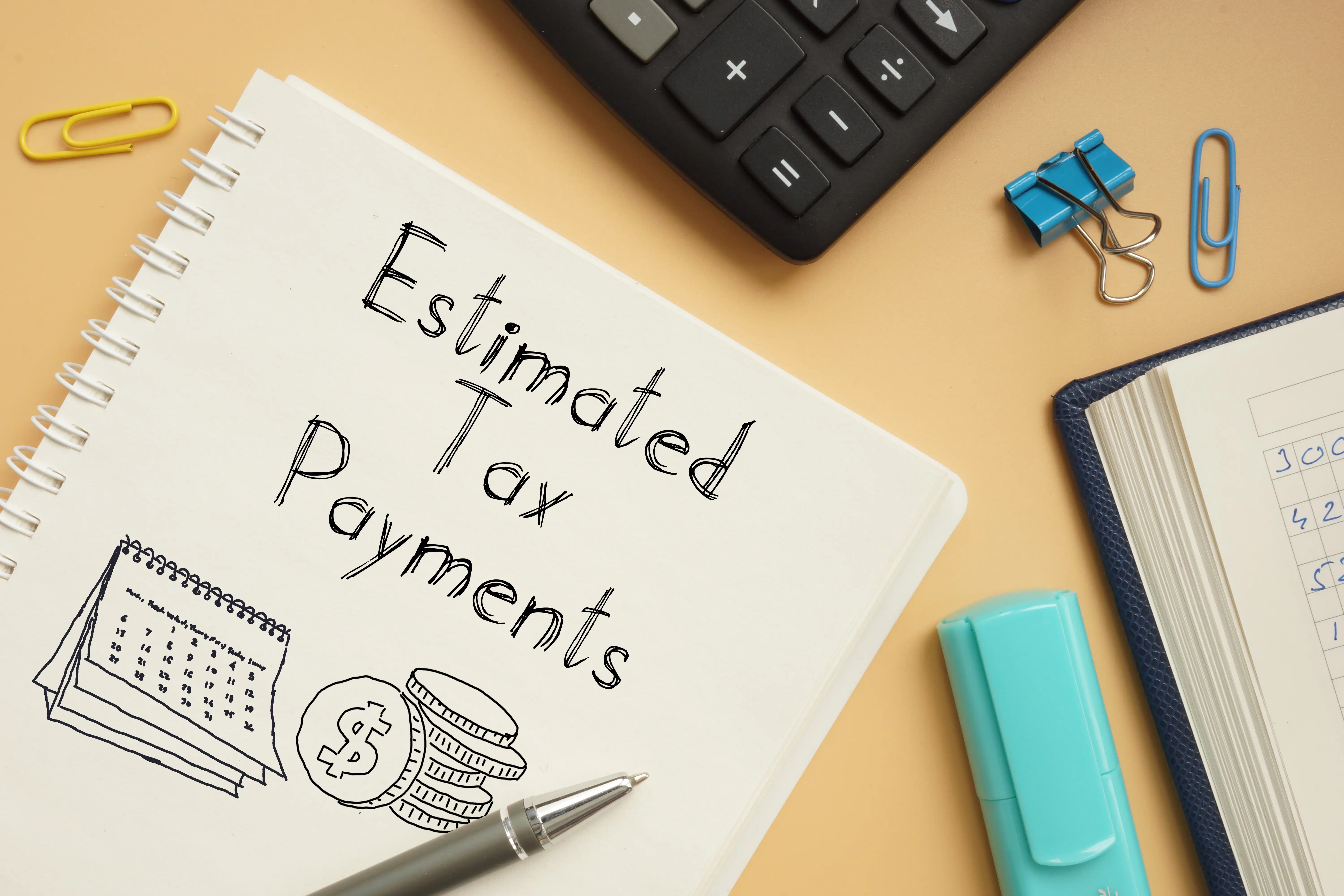This is the eighth post in our “Starting a Business Series”.
Estimated taxes are a topic or area that often confuses both new and established business owners. My hope here is to give you a clear understanding of what estimated taxes are, how you calculate them, and how you pay them.
By gaining this knowledge it help you avoid having big tax surprises along with potential interest and/or penalties!
When Do You Owe Taxes On Your Earnings?
The US Tax System is a pay as you go system. This basically means that as your earn money you owe taxes on it.
This is idea is often surprising or confusing. Essentially, if you make $85,000 in the first quarter of the year, you do not have until you file your tax return to pay the taxes on that. Rather, you owe taxes on that in Q1.
Let’s look at this as a W2 earner because it will help hopefully make the picture more clear.
Imagine you are a highly compensated W2 employee earnings $340,000 a year ($85,000 per quarter). As you get your paycheck every other week your employer will pull all sorts of taxes out of it (Federal Withholding, State Withholding, and FICA which is Social Security and Medicare). In this scenario you are paying taxes as you earn the money, your employer is just calculating and paying that for you, on your behalf.
Now lets flip the switch, you are a new business owner that made $85,000 in quarter 1. You have no employer, you are your own boss and you are responsible for paying those taxes on your own, as you earn the money.
This is where estimated taxes come in. They are a vehicle to pay taxes into both the federal and state agencies on a somewhat quarterly basis to cover the amount you earn or expect to earn.
One thing to note, if you are an S Corp and taking a salary as the owner, you are likely paying in taxes on that salary amount, but the amount you take as a distribution you would not be.
How Does the Year-End Tax Return Play Into All Of This?
Your year-end tax return is simply a reconciliation of what you earned, what you paid, and then reporting all of that to the government agencies. Based on your report (tax return) you will either receive a refund or owe taxes to the government.
Refund – A refund simply means that you paid too much in taxes throughout the year and the government is just giving that overpayment back to you.
Amount Owed – An amount due when filing simply means that you did not pay enough in taxes throughout the year and you need to cover the rest of your bill. There is potential to have both interest and penalties if you end up owing taxes at year-end.
That is it, the year-end tax return is simply sending information to the government agencies that tells them what you earned throughout the year and any payments you made. Think of it like a reconciliation and you are just truing up with the government at that time.
When Are Estimated Taxes Due?
Estimated taxes are due on a “quarterly” basis. However, for whatever reason, when it comes to estimated taxes the IRS does not recognize the normal quarters so I want to clearly outline what months are included in each quarter for estimated tax purposes.
- Quarter 1 (January thru March Earnings): Due April 15
- Quarter 2 (April and May Earnings): Due June 15
- Quarter 3 (June thru August Earnings): Due September 15
- Quarter 4 (September thru December Earnings): Due January 15
Again, you may be thinking we made a mistake on the periods above but I can assure you those are accurate.
How Do I Calculate Estimated Taxes?
When we talked about calculating estimated taxes we really have two options:
- Safe Harbor Method – The IRS has a safe harbor option which basically means if you pay a certain amount of dollars via quarterly estimates, you will not owe any interest and penalties at year-end, even if you under paid.
- Here are the safe harbor options to avoid any penalties and interest:
- Pay 90% of your actual tax liability for the current year.
OR
- Pay 100% of your tax liability for the previous year.
- If your adjusted gross income is over $150,000 then it is 110% of your tax liability for the previous year.
- Pay 90% of your actual tax liability for the current year.
- Lets imagine last year you earned $50k and this year you won the lottery and made $1MM. If you make the minimum required estimated tax payments, even though you will owe a ton more this year, you will not be faced with interest or a penalty. Key Note: You still will owe the taxes at year-end you just will not have to fork more than that over.
- This is by far the easiest method and recommend for those that have consistent income. If you have big swings in income this method could leave you with a surprise bill at year-end.
- Here are the safe harbor options to avoid any penalties and interest:
- Actual Method – This method is where you take your actual business income and other earnings that are occurring throughout the year and then run the numbers as if it is a “mock” tax return to get an estimate of what your taxes will be based on the results.
- This method is more difficult and can be time consuming but will be the most accurate as you are using live data instead of basing it off of prior year.
- I have not been able to find a perfect calculator for this but here are two options of possible ones to use. Just be sure you run the results past your tax preparer if you want verification:
- Simplified Version
- Detailed Version (Recommended)
What Happens If I Do Not Pay Estimated Taxes (or Underpay)?
If you do not pay enough taxes throughout the year (either through withholding or estimated taxes) you may have to pay a penalty for underpayment of estimated tax. We talked about a way to avoid that penalty, via the safe harbor method.
The amount of the penalty or interest simply depends on how late you are but it is typically calculated based on 0.5% of the amount you owe for each month you’re late, up to a maximum of 25%.
How Do I Pay Estimated Taxes?
You can pay estimated taxes to the IRS online or via check. Here are the IRS options:
- Pay Online via Bank Account or Debit/Credit Card: https://www.irs.gov/payments
- Pay via Check and Form 1040-ES (Vouchers Start on Page 11): https://www.irs.gov/pub/irs-pdf/f1040es.pdf
For your state you will want to check specifically on their website to see payment options available!
Hopefully this was helpful and now you can be on top of paying your estimated taxes on time and avoiding any penalty.
-
The Time Is NOW To Start Paying Less In Taxes. Join TaxElm and start eliminating taxes and growing your wealth!
What you’ll get:
- Tax Savings Blueprint and Training: We’ll provide you with a customized tax plan that is tailored to meet your specific needs and goals. Along with that, you have access to our library of training modules, implementation guides, supporting documents, and more.
- Unlimited Access to Tax Experts: Got a specific question about a tax strategy? You’ll have access to our team of tax experts to get the accounting and tax answers you need.
- Annual 1-on-1 Live Consultation: Once a year you get a live meeting with a tax expert to discuss anything tax savings you would like. This is your time to get your questions answered live 1-on-1.
- Annual Bookkeeping Analysis: Annually you will submit your financials to our team of accountants and we will put together a high level business financials overview report custom to your business.
- Monthly Group Webinar and Training: Every month, we host a live, virtual training session on a key tax topic. Join us live and bring your questions or view the recording on your own schedule.
- Partner Directory and Discounts: You get exclusive, members-only rates and access to our expert referral network for accounting, bookkeeping, tax preparation, payroll, financial planning, legal, retirement planning, tax resolution, and more!
It is like having a tax strategist walking with you along this entrepreneurial journey!








